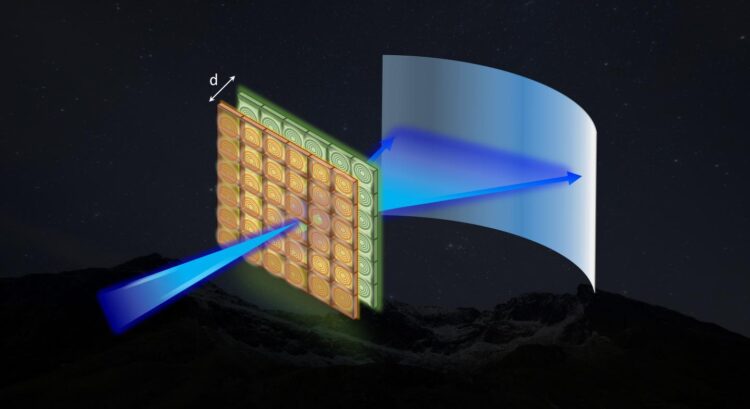
Credit: by Ziqian He, Kun Yin, and Shin-Tson Wu
Flat optics based on patterned liquid crystals (LCs) has recently received extensive research interest. Comparing with dielectric metasurfaces which are usually fabricated by sophisticated lithography process, LC polymer-based planar optics, owing to the self-assembly properties, can be fabricated through all-solution process. During the past decades, a variety of planar optical devices have been demonstrated based on geometric phase (also termed as Pancharatnum-Berry phase) manipulation. The total effective thickness of the device, including the underlying liquid crystal alignment layer and the liquid crystal polymer, is usually in the order of 1 μm. Amazingly, commercial-quality transmissive lenses, gratings, optical vortex processors, etc., have been developed in the past few years. Engineering of their operating spectral/angular bands has been illustrated in both passive and active devices. For example, a multi-twist structure can be designed to customize the spectral/angular bandwidth as a passive means, while active devices that can respond to external stimuli such as mechanical stress, electric field, and light, have also been realized. Nevertheless, the existing explorations have been focused on optical functionalities that can be fulfilled by a single-layer device. One way to go beyond the current limit is to design cascaded flat optics, where more degree of freedom is involved and thereby more distinct functionalities can be rationally achieved. In the meantime, the cascaded optical elements should still preserve the advantages such as high efficiency, compact and lightweight, easy processing, flexibility, and low cost.
In a new paper published in Light Science & Application, a team of scientists, led by Prof. Shin-Tson Wu from the College of Optics and Photonics, University of Central Florida, USA, proposed a cascaded LC flat optical element, termed miniature planar telescope, to achieve steering angle magnification independent of the incident beam position. Such an angle magnification function cannot be achieved with a single layer optical device such as a grating or a refractive surface. This miniature planar telescope consists of two flat optical elements, as schematically shown in Fig. 1. Both layers are assigned phase profiles following the sum of even order polynomials and they are separated in space by d. Through ray-tracing simulations, the system can be optimized according to specific aperture size and incident angle range, and nearly diffraction-limited performance can be obtained.
In experiments, different LC diffractive devices in millimeter sizes with various f/# were fabricated through all-solution processing and assembled into two telescope modules with designed magnification factors of 1.67 (module I) and 2.75 (module II), respectively. The measured magnification agreed well with the designed values. Moreover, a reasonably high efficiency (>89.8% for module I and >84.6% for module II) was achieved within the designed incident angle range. Through error analysis, the efficiency could be improved by optimizing the fabrication process. The team demonstrated that the telescope module can be a promising candidate for non-mechanical beam steering to expand the currently limited steering range (also known as field of regard). For example, for LiDAR (light detection and ranging) applications at λ=905 nm, a maximum output angle range of ±27° can be expected. Comparing to a high-efficiency optical phase array (most matured electronic beam steerer) with an incident field range of ~±5°, a magnification of 5.4 can be acquired. For a longer operating wavelength, say λ=1550 nm, the steering range can be expanded to about ±37°, corresponding to a magnification of 7.4. In this regard, the team also characterized the output beam profile to ensure the high quality of the telescope modules and the compatibility with high-end beam steerers.
With the presented work, Wu and co-workers demonstrated lightweight, cost effective, miniature planar telescopes for optical angle magnification based on LC polymer flat optics. High efficiency, designable magnification factors, and excellent beam quality make the proposed telescopes highly promising for practical applications requiring advanced laser beam steering technology. More importantly, this is a new milestone for planar LC optics to go beyond its current development.
###
Media Contact
Shin-Tson Wu
[email protected]
Related Journal Article
http://dx.





